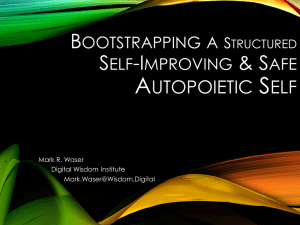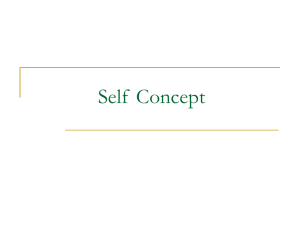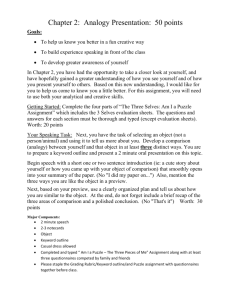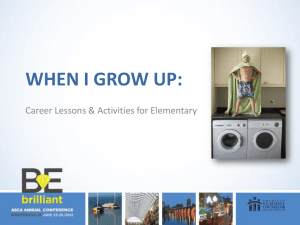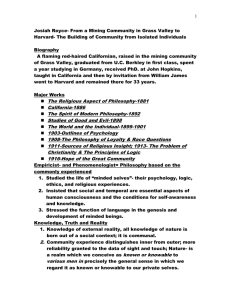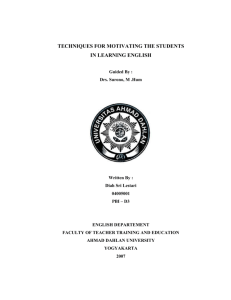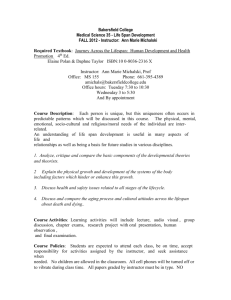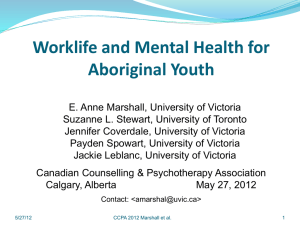Student Motivation through Possible Selves
advertisement
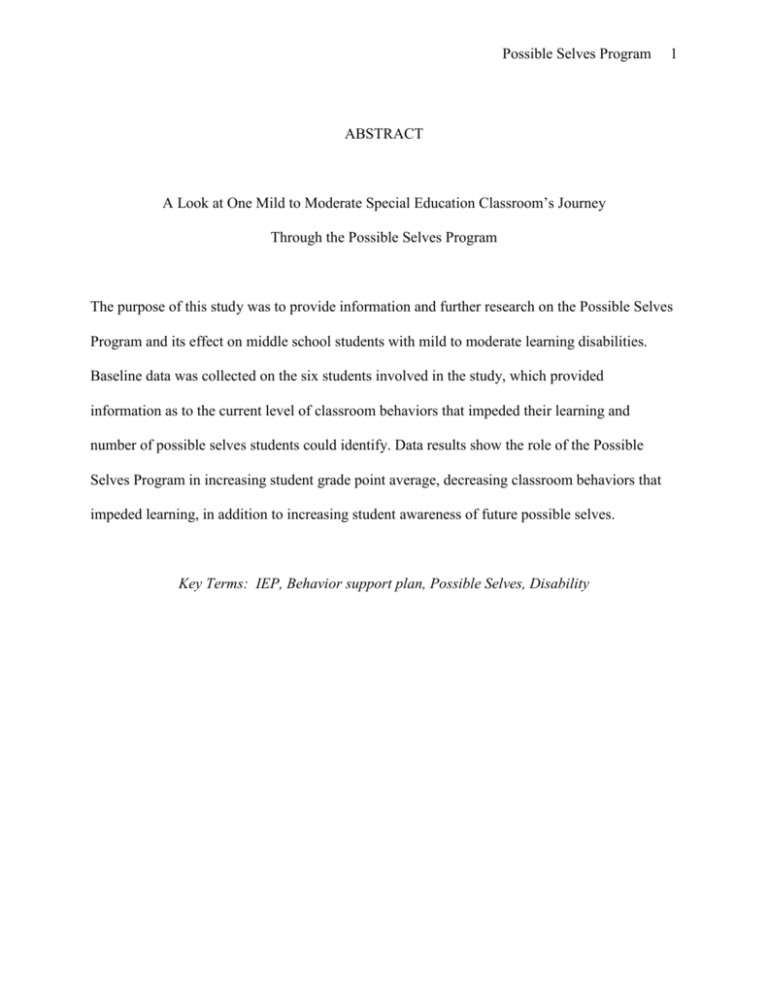
Possible Selves Program 1 ABSTRACT A Look at One Mild to Moderate Special Education Classroom’s Journey Through the Possible Selves Program The purpose of this study was to provide information and further research on the Possible Selves Program and its effect on middle school students with mild to moderate learning disabilities. Baseline data was collected on the six students involved in the study, which provided information as to the current level of classroom behaviors that impeded their learning and number of possible selves students could identify. Data results show the role of the Possible Selves Program in increasing student grade point average, decreasing classroom behaviors that impeded learning, in addition to increasing student awareness of future possible selves. Key Terms: IEP, Behavior support plan, Possible Selves, Disability Possible Selves Program 2 The Possible Selves Program is a series of lessons and activities that aim to nurture student motivation and academics. Michael Hock, Donald Deshler, and Jean Shumaker created the program as a guide for teachers working with students of all ages. The lessons and activities found in the program get students thinking about their strengths, interests, hopes, expectations, and fears. The program then guides students in creating short and long-term goals. The Possible Selves Program can be used in many ways such as an intervention piece, to enhance grade-level curriculum, or to guide students during times of transition. The purpose of this study was to see if implementing the Possible Selves Program into a mild to moderate special education classroom would increase student GPA, decrease classroom behaviors that impede learning, and increase students’ ability to identify possible selves. By incorporating the Possible Selves Program along with the core curriculum materials, it will provide students with additional strategies to find success in school and beyond. The effectiveness of the Possible Selves Program was measured by comparing student GPA and classroom behavior prior to and after the implementation of the Possible Selves Program. In addition, its’ effectiveness in increasing students’ awareness of possible selves was measured by a teacher-student interview and student work samples. The question guiding this study was how does implementing the Possible Selves Program into a mild to moderate special education classroom affect student GPA, classroom behavior that impedes learning, and ability to identify possible selves? Throughout all grade levels and subject areas a common concern found among teachers is student motivation. To combat this concern many teachers work tireless hours tending to the various needs of their students. They create fun and engaging lessons, research and implement best strategies for teaching, and are constantly revising their behavior management skills; skills Possible Selves Program 3 that often must be tweaked every year and sometimes every month! What is interesting about these actions, though important and necessary, is they are direct actions done by the teacher and only the teacher. What about the students? Implementing the Possible Selves Program into a classroom along with core curriculum materials is a way to give students more responsibility in the learning process. Teachers act as guides or mentors while students engage in a path of selfdiscovery. Students learn about their individual strengths, interests, and desires and then create goals based on these. Students begin to take ownership of learning and are more motivated because learning becomes personal. Literature Review The expectations of this study aimed to discover the effectiveness of the Possible Selves Program in improving student academics, shaping behavior, and broadening self-awareness. It will focus on six 8th grade students with diagnosed learning disabilities enrolled in a particular Algebra Readiness and US History class. Qualitative in nature and quantitative in data, this study will examine the various outcomes that surface as a result of their involvement in the Possible Selves Program. Specifically, this research will look at student GPA (grade point average), classroom behavior that impedes learning, and ability in identifying future possible selves. These areas will be examined both before and after the implementation of the Possible Selves curriculum. This study incorporated previous literature involving possible selves theory and research related to this topic. Student Motivation and Goals Self-awareness was a foundational component to successful life transitions. The ability to identify personal hopes, fears, preferences and potential can have a great impact on one’s future. Possible Selves Program 4 Without this self-knowledge future possibilities or identified goals can become quite limited. Furthermore, having a strong sense of self can be rather motivating. When one understands who they are, where they want to go in life, and what they wish to avoid the daily tasks of getting there become a personal necessity, whether they are enjoyable or not. This is known as intrinsic and extrinsic motivation. Intrinsic motivation can be looked at as motivation that comes from within a person. An intrinsically motivated person participates in something because they enjoy it or are interested in it. They do not care about external rewards or praise. An extrinsically motivated person, on the other hand, is motivated by outward conditions. They do something because of external rewards or consequences such as making a lot of money or not graduating from high school. Earlier research on intrinsic and extrinsic motivation found these two ideas to be at odds with one another. A person was either motivated by one or the other; not both. However, Lepper, Henderlong-Corpus, and Iyengar (2005) argued “this opposition is not always necessary or appropriate in the average classroom” (p. 190). They go on to explain that intrinsic and extrinsic motivation often coexist in classrooms and that “working to enhance both intrinsic motivation and the internalization of extrinsic motivation may help to maximize – or, at least, to minimize the loss of – children’s motivation to learn” (Lepper, Henderlong Corpus & Iyengar, 2005, p. 193). Possible Selves is Born In an effort to complement current conceptions of self-cognition and motivation, Hazel Markus and Paula Nurius first introduced the concept of Possible Selves in 1986. Markus and Nurius (1986) explained possible selves as a representation of what a person believed they might become, would like to become, and are afraid of becoming . Furthermore, they stressed the Possible Selves Program 5 importance of possible selves “first, because they function as incentives for future behavior (i.e., they are selves to be approached or avoided) and second, because they provide an evaluative and interpretive context for the current view of self” (Markus & Nurius, 1986, p. 955). In other words, possible selves can be linked to motivation and to change (Markus & Nurius, 1986, p. 966). Research Exploring Possible Selves After the initial introduction and coining of the term possible selves, various descriptive studies were conducted that explored the hopes, expectations, and fears of various groups of students. In one study, conducted by Perry and Vance (2010), the academic and occupational possible selves of 216 urban youths of color ranging in age from 13 to 17 years old were considered. Results from this research found that, “on average, students hoped for and expected to get higher levels of schooling, as well as more prestigious jobs, than what they feared attaining” (Perry & Vance, 2010). These hoped for and expected higher levels of schooling and occupations were also similar in terms of prestige and there was no significant difference found among the schooling that boys and girls hoped for, expected, or feared. In addition, they did not find gender differences in regards to the total number of feared occupational selves that were identified by the youths. That is both boys and girls identified a similar number of feared occupational selves (Perry & Vance, 2010). However, considerable differences were noticed in “the proportion of boys versus girls representing occupations across different selves categories” (Perry & Vance, 2010). Interestingly, the research found that girls were more likely to hope for or expect historically male-dominated occupations of physician, lawyer, and businessperson while they feared becoming teachers more than boys. Perry and Vance (2010) point out that this is at odds with Possible Selves Program 6 scholarship claiming that girls and women prefer Social occupation types (p. 265). The research also found that mostly boys hoped for a career as an athlete, “one of the few high-earning jobs where men of color are represented” (p. 265). In another study, Oyserman et al. (2003) hypothesized that possible selves improved academic outcomes only if it served as a plausible self-regulator. In other words, merely having an awareness of one’s possible selves was not a sufficient contributor to one’s success unless it actually influenced behavior. Their research included a sampling of 160 randomly selected 8th grade students attending three inner city middle schools serving low-income families in Detroit (Oyserman et al., 2003, p. 134-5). As hypothesized, the findings revealed “youths with academic possible selves that could plausibly serve a self-regulatory focus had academic outcomes that differed significantly from their peers, with improved classroom participation and grades and reduced chance of summer school referral, as well as increased time spent in homework compared to their peers” (p. 144-5). In addition, the study focused explicitly on short-term goals among the youths. While the authors believe that youths do consider future adult possible selves they believe that they would be less likely to serve as self-regulators of their current behavior (p. 145). As a result, they propose working with youth on present and shorter term possible selves so that they could receive feedback regarding their successes more quickly. A third study, conducted by Pizzolato (2007), took a different approach in that she looked at students’ coping ability when faced with impossible selves. The participants consisted of 32 college students attending a large, public, midwestern, research university. According to Pizzalato (2007): (W)hen confronted with a sizable threat to the viability of their career-possible self, whether students were able to reenter the career development processes depended on Possible Selves Program 7 whether they could effectively balance their hopes and fears regarding their possible-self goals. Without this balancing ability, students may abandon their career goals. Balance allowed the other group not just to retain or appropriately revise their goals but to do so in a way that solidified for them their motivation for proceeding and the modifications they needed to make to best support their own future successes (pg. 218). Other reviewed literature included participants that ranged from college students, youth between the ages of 13 and 16 attending public school, and a related study including Hispanic students ranging from 2nd to 7th grade. These studies showed that the exploration of possible selves played a positive role in enhancing student motivation in regards to learning. In looking at the research surrounding possible selves it can be concluded that the exploration of possible selves can have a positive effect on students. Regarding gender, boys and girls appear to have no differences in the prestige of their possible selves or the level of schooling they hope to achieve. Furthermore, both boys and girls express similar numbers of feared possible selves. The research also indicates that having an awareness of one’s possible selves is not a sufficient contributor to one’s success unless it actually influences behavior. Finally, having the ability to balance one’s hopes and fears when being faced with impossible selves is crucial in re-evaluating possible selves goals. The Possible Selves Program While extensive research has been done on the concept of possible selves, it was not until almost twenty years later that a group of researchers decided to create and implement a program modeled after possible selves theory that can be used by teachers to enhance student motivation both intrinsically and extrinsically. From their efforts was born the Possible Selves Program (Hock, Deshler, & Shumaker, 2003, p. 11 & 12). Possible Selves Program 8 The Possible Selves Program, created by Hock, Deshler, and Shumaker, was “designed to increase student motivation by having students examine their future and think about goals that are important to them” (Hock et al., 2003, p. 12 & 13). The curriculum was comprised of 7 lessons that can be used with students at the elementary age up to college and adult school. In addition, the lessons can be adapted or modified to meet the needs of individual groups of students. Each lesson focuses on six components. These components include (1) Discovering, (2) Thinking, (3) Sketching, (4) Reflecting, (5) Growing, and (6) Performing. More specifically, students that participate in the program “think about and describe their hoped-for possible selves (selves they would like very much to create; a wish or a dream), expected possible selves (selves they are fairly sure they can create), and feared possible selves (selves this wish to avoid)” (Hock et al., 2003, p. 13). As students are guided through the program they can participate in activities such as watching a movie, making a collage, creating a Possible Selves Tree, and completing an Action Plan. Research Supporting the Possible Selves Program Since the development of the Possible Selves Program, studies about the curriculum could only be found within the group of researchers that created the program. Two of their studies focused on freshmen university student-athletes. In the first study, students participating in the Possible Selves curriculum were able to identify goals with a significantly higher score than students in the control group. In addition, the control groups’ ability to identify goals decreased during the first semester while the possible selves group maintained or slightly increased. The findings also noted that after six years the students in the possible selves group had higher grade point averages (GPAs) and higher graduation rates (75% compared to 45%) (p. Possible Selves Program 9 21). In the second study, the possible selves group identified more roles and goals for themselves in the areas of athletes, learners, and persons than the control group. Finally, 75% of the possible selves group was on track to graduate compared to 56% of the control group (p. 22). Their third study looked at 52 middle-school students both with and without disabilities attending an urban school with a diverse population. The results of this study showed that students participating in the Possible Selves Program “identified significantly more roles they hoped to play in the future than did students who participated in the traditional career orientation curriculum” (Hock et al., 2003, p. 23). In addition the possible selves students discovered and had more specific goals as learners and persons compared to the other students. Conclusion To address the lack of readily available materials which explore and enhance the possible selves of students, a group of researchers created the Possible Selves Program. The purpose of the program is to increase student focus and academic motivation both intrinsically and extrinsically. While the literature reviewed on the Possible Selves Program proves promising more research from sources other than the creators might create a more complete picture of its’ capability. Furthermore, it is lacking detailed research on how the program affects students with mild to moderate learning disabilities. This research, therefore, seeks to explore the effects of the Possible Selves Program in a more intimate manner among this population of students. Methodology The study took place in a classroom located at a public school known as Magnolia Middle School. The room is identified as a mild to moderate special education classroom where students are provided with mainstreaming opportunities daily. In particular, the classroom serves Possible Selves Program 10 8th grade students using the same core curriculum materials provided to the general education population. In addition, students participating in the special education program at Magnolia are held to the same academic and behavioral standards required for graduation. These requirements included a cumulative GPA at or above a 2.0, passing The Constitution Test, and reading eight literature books approved by students’ language arts teacher. Magnolia Middle School was located in a mid-sized urban city found in central California. Student enrollment averages around 900 students and, according to the U.S. Department of Education’s website, the school was classified as a low-income school for the 2010-2011 school year. In addition, roughly 94% of the students at Magnolia were receiving free or reduced price meals. Finally, the students enrolled at Magnolia were grouped in the following ethnicities by percent of total enrollment: 76.1% Hispanic or Latino/a students, 12.85% Black or African American students, and 9.13% White or Caucasian students. The remaining 1.92% were grouped in the categories of American Indian or Alaskan Native, Asian, Filipino, and Native Hawaiian/Pacific Islander. Participants This study was conducted by the classroom teacher, and included one instructional assistant, in addition to six students. The classroom schedule was as follows: Periods 1 & 2 – 8th grade Algebra Readiness (12 students) Period 3 – IEP (Individualized Education Program) Preparation Periods 4 & 5 – 8th grade Algebra Readiness (8 students) Period 5 – Lunch Period 7 – 8th grade History Social Science (6 students) Possible Selves Program 11 The six students participating in Possible Selves Program were enrolled in the Algebra Readiness class during 4th and 5th period in addition to the History Social Science class during 7th period. The classroom teacher and author was a 26-year-old Caucasian female who had been working as a mild to moderate special education teacher for three years. She had a Bachelor of Arts degree in Sociology with minors in Religion and Women’s Studies. She also held a Level 1 Education Specialist Instruction Credential with authorized subjects in Mild/Moderate Disabilities and Moderate/Severe Disabilities. Finally, the author was currently working on a Master of Arts in Education with an emphasis in Special Education. Lupe was a 46-year-old Latina instructional assistant who had been working with the mild to moderate special education population for 4.5 years. Lupe held a high school diploma and an Associates degree in Child Development. In addition, she was enrolled in an online Elementary Algebra class from a local junior college during the course of the study. Lupe and the classroom teacher had worked together in this classroom since August of 2008. The research project began with a total of 6 students. All of these students were diagnosed with a mild to moderate learning disability and were being served through an IEP (Individualized Education Program). These students participated in specialized academic instruction in the areas of Reading Language Arts, Mathematics, and History Social Science. This translated into 71% of their school day. For the other 29% of their school day students participated in the general education environment for lunch and alternated between PE (physical education) and Science every other day. The first participant, Reina, was a 13-year-old Latina student. Reina was assessed for special education services at the age of 5. She was found eligible for Special Education with a primary disability of MR (Mental Retardation). In 2011, her primary disability title was changed Possible Selves Program 12 to ID (Intellectual Disability) but the definition stayed the same. Reina’s primary language is English. She lives at home with her father, mother, and older brother. There is a history of learning disabilities in her family. The second participant, Angel, was a 14-year-old Latino student. Angel was assessed for special education services at the age of 9. He was found eligible for special education with a primary disability of SLD (Specific Learning Disability). Angel’s primary language is English. He lives at home with his mother, older sister, and younger brother. In addition, Angel was being served with a BSP (Behavior Support Plan), had an assigned parole officer, had been expelled from his previous school, and was considered a truant during the time of the study. The third participant, Elisa, was a 13-year-old Latina student. Elisa was assessed for special education services at the age of 8. She was found eligible for special education with a primary disability of SLD. Elisa’s primary language is English. She lives at home with her mother and two older brothers. Two years ago, one of Elisa’s older brothers was diagnosed with cancer. During this time, Elisa’s mother was gone for extended periods of time to Los Angeles for hospitalizations and treatment. Her brother is currently in remission. Finally, Elisa’s grandmother was receiving hospice care and passed away during the time of the study. The fourth participant, Zelek, was a 13-year-old African American student. Zelek had been exited from special education previously and was reassessed for services at the age of 12. He was found eligible for special education with a primary disability of SLD. Zelek’s primary language is English. He lives in a group home with similar aged boys although his mother has responsibility of his educational rights. Zelek has 6 siblings that still live with his mother. His father is deceased. Zelek has a history of premature birth, seizures, head injuries, GERD (Gastroesophageal Reflux Disease), and substance abuse. Prior to attending Magnolia Middle Possible Selves Program 13 School Zelek was attending a school for students with severe behavioral issues. In addition, during the time of the study, Zelek was being served with a BSP and was taking medication for ADHD (Attention Deficit Hyperactivity Disorder). The fifth participant, Darion, was a 14 turned 15-year-old African American student. Darion was assessed for special education services at the age of 10. He was found eligible for special education with a primary disability of SLD. Darion’s primary language is English. He lives at home with his mother and has older siblings that live outside of the home. The sixth and final participant, Maggie, was a 14-year-old American Indian student. Maggie was assessed for special education services at the age of 7. She was found eligible for special education with a primary disability of SLD. Maggie’s primary language is English. She lives at home with her mother, older sister, the baby of her older sister, two younger sisters, and a same-age male cousin. In addition, her mother’s boyfriend lives in the home with his three children. Maggie has a history of seizures and at one point lived in a women’s shelter with her mom and three sisters. Finally, at the time of the study it was discovered that Maggie was 4 months pregnant. As a result she went on Independent Study and was unable to finish her participation in the Possible Selves Program. Maggie attended her graduation ceremony in June 2011 and graduated with her peers. Materials The week before the Possible Selves Program was introduced to the students the teacher spent five school days collecting baseline data. The teacher created a chart consisting of five behaviors that she observed as being impeding to her students’ learning. These behaviors included: socializing/talking, head down/sleeping, drawing/passing notes, refusal to work/”I Possible Selves Program 14 can’t”, and tardy/absent. This chart was also used the following week after the completion of the Possible Selves Program to collect post-behavior data. In addition to the teacher made chart, other materials used included a computer program known as Complete Schools and a teacher-student interview. The Complete Schools program is a secure database system which is used by Magnolia Middle School to record a wide variety of information regarding its’ students. The program was used to obtain and compare pre-and postGPA data. The teacher-student interview consisted of three questions: (1) What do you hope for in your future or in life? (2) What do you expect will happen in your future or in life? and (3) What do you fear will happen in your future or life? The teacher-student interview was used to obtain students’ ability in identifying possible selves prior to their participation in the Possible Selves Program. Once the baseline data was collected, the teacher began the Possible Selves Program using the book Possible Selves: Nurturing Student Motivation (Hock, Schumaker & Deshler, 2008). This manual, written by the creators of the Possible Selves Program, includes seven stepby-step lessons complete with permission to copy materials that are referred to in the lessons. Some of these instructional materials included the Movie Questionnaire, Possible Selves Goal Folder Template, Possible Selves Unit Organizer, Possible Selves Questionnaires, definitions, Questionnaire Highlights, example Possible Selves Trees, blank tree templates (See Appendix B), Action Plan, in addition to various quotes, pictures, and example scenarios to be used as overhead transparencies. In addition, students watched the film Annie O (1995) as recommended in the first lesson. Finally, throughout the various lessons students used construction paper, magazines to create a collage, classroom computers, glue, scissors, pencils, pens, colored pencils, and markers. Possible Selves Program 15 Procedures The total length of this study was 10 school weeks. The first and tenth week of the study my instructional assistant and I recorded student behavior using the teacher-made behavior chart. Behavior was recorded during 4th and 5th period. Although the class had 8 students enrolled, we only took data on the 6 students that would be participating in the Possible Selves Program during 7th period. Furthermore, students were unaware that this information was being recorded and classroom routines were carried out as usual. During these weeks GPA and Possible Selves identification data was also collected. The other eight weeks were devoted to the implementation of the Possible Selves Program. On the first two days students watched the movie Annie O and completed the Movie Questionnaire. On the third day, the program was introduced to the students. Group rules were created by the students, written down, and displayed in the classroom. The following 37 consecutive school days were devoted to working through the Possible Selves Program lesson by lesson at a pace that was relaxed and student friendly. Analysis The data in this project was analyzed using three methods. The first method involved an in-depth scale of comparing baseline data to post-data on student behavior that impeded learning. Both my instructional assistant and myself collected data individually and then an average was taken of the two. This was done in order to ensure a more accurate depiction of the behaviors that were occurring in my classroom. The second method the teacher used was a comparison of grade point average prior to and after the implementation of the Possible Selves Program. The third and final method used involved comparing student responses to a teacher-student interview and then comparing them to work samples from the Possible Selves Program. Specifically, Possible Selves Program 16 students ability to identify their hoped for selves, expected selves, and feared selves were compared. Findings Overall, the study showed that incorporating the Possible Selves Program into a special education classroom had a positive effect on students in all areas. At the end of the ten weeks, there was a significant increase in four out of the six students GPAs. The other two student GPAs remained the same. In addition, for 5 out of the 6 students, there was a significant decrease in classroom behaviors that impeded learning. Finally, for 5 out of the 6 students, their ability to identify possible selves appeared to increase over the course of the study. Figure 1 – 3rd Quarter GPA vs. 4th Quarter GPA Possible Selves Program 17 The growth was apparent when students’ 3rd quarter GPAs were compared to their 4th quarter GPAs (See Figure 1). Reina, Elisa, and Angel’s GPAs all increased by 0.43 grade points. Darion’s GPA increased by 0.57 grade points while Zelek and Maggie’s GPA neither increased or decreased. However, it is important to note that although Maggie’s GPA stayed the same her scores are not valid in that she did not complete the Possible Selves Program. As a result of her pregnancy, Maggie went on Independent Study starting April 13, 2011. Therefore, the teacher was only able to collect baseline data on her. Her participation in the Possible Selves Program lasted 3 weeks and 2 days while the other students participated in and completed the program in 8 weeks. Individual Findings When analyzing the data for classroom behavior that impeded learning, it was apparent that Reina experienced the most growth (See Figure 2). Prior to participating in the Possible Selves Program, Reina engaged in behaviors that impeded her learning on a daily basis with a total of 24 occurrences recorded in the baseline data. After her participation in the Possible Selves Program, however, her impeding behaviors became almost non-existent with only 1 occurrence of a behavior that impeded her learning. Overall, she had 23 less occurrences when the post-data was collected. Possible Selves Program 18 Figure 2 – Reina In considering Reina’s classroom behavior that impeded her learning it is important to note that when the post-data was collected she sat at a desk alone. When the baseline data was collected she sat next to Maggie, one of her best and only friends in that particular classroom. Therefore, Reina’s scores may be skewed due to the change in seating and participants. Possible Selves Program Figure 3 – Angel Angel showed the next growth with an overall of 19 less occurrences of behavior that impeded his learning (See Figure 3). Again, though, it is important to note that the data may be skewed. When data on classroom behavior that impeded learning was collected the week after the students finished the Possible Selves Program Angel ditched school on Monday and was suspended on Tuesday. As a result, I was only able to collect data on Angel for a total of three days. 19 Possible Selves Program Figure 4 - Elisa While not as significant as the others, Elisa did show a decrease in classroom behaviors that impeded her learning. Her data shows 3 less occurrences when compared to the baseline (See Figure 4). Elisa’s main behavior that impedes her learning is socializing during class. The data shows a great improvement in this area as she almost cut this behavior in half. Interestingly, being tardy to class increased by 2 occurrences. 20 Possible Selves Program 21 Figure 5 - Zelek After completing the Possible Selves Program Zelek showed an overall growth of 4 less occurrences of classroom behavior impeding his learning when compared to the baseline data (See Figure 5). Zelek made the most growth in the area of socializing with one fourth less occurrences recorded. Similarly to Elisa, though, being tardy to class increased by 2 occurrences. Possible Selves Program 22 Figure 6 – Darion When analyzing the data for classroom behavior that impeded learning, it was apparent that Darion’s growth was similar to Elisa’s. Overall, he had 3 less occurrences of classroom behavior that impeded his learning (See Figure 6). According to the baseline data, his top two areas of behavior that impeded his learning were Socializing/Talking and Head Down/Sleeping. He experienced the most growth in the area of socializing while his engaging in putting his head down or sleeping did not change. In addition, Darion’s Refusal to Work/”I can’t” behavior increased by 1 over the course of the study. As mentioned previously, no post-data was collected for classroom behaviors that impeded Maggie’s learning due to her going on Independent Study. Therefore, no chart will be displayed. Possible Selves Program 23 Finally, growth was also apparent when students’ ability to identify possible selves was compared before and after their completion of the Possible Selves Program (See Figure 7). Reina, Angel, Elisa, Zelek, and Darion all experienced a significant increase in their ability to identify various possible selves that they hoped for, expected, and feared while Maggie’s data was inconclusive as she was not able to complete the Possible Selves Program. For the students that showed growth in this area, it was interesting to see the possible selves they identified after their completion of the program become more detailed and varied. For example, Elisa stated before she started the program that she hopes to have her own line of cosmetics. When asked what she expects she said she didn’t know. After the program she stated that she expects to finish high school, go to Beauty College, in addition to finishing college. When asked what she hoped for she said to have her own makeup brand, and have a makeup boutique. Through the help of the Possible Selves Program Elisa was able to take her interest of makeup and explore it more fully. She began to see how school was a stepping-stone to help her get to where she wanted to be. Possible Selves Program 24 Figure 7 – Identified Possible Selves In looking at Figure 1 on page 34, comparing individual findings, and looking at Figure 7 above the growth that students experienced can be seen. Incorporating the Possible Selves Program into their daily curriculum had a positive effect on student GPA, classroom behavior, and their ability to identify more possible selves. Discussion The purpose of this study was to see if implementing the Possible Selves Program into a mild to moderate special education classroom would increase student GPA, decrease classroom behaviors that impede learning, and increase students’ ability to identify possible selves. By incorporating the Possible Selves Program along with the core curriculum materials, it will provide students with additional strategies to find success in school and beyond. The effectiveness of the Possible Selves Program was measured by comparing student GPA and Possible Selves Program 25 classroom behavior prior to and after the implementation of the Possible Selves Program. In addition, its’ effectiveness in increasing students’ awareness of possible selves was measured by a teacher-student interview and student work samples. Summary Overall, the study showed that when the Possible Selves Program was implemented for eight weeks along with core curriculum materials students experienced positive gains in their GPA, classroom behavior, and their ability to identify possible selves. Out of the six students in the study, four of them increased their GPA while the other two students’ GPAs stayed the same (See Figure 1 on page 34). In addition, five of the six students showed improvement in decreasing classroom behavior that impeded their learning (See Figures 2 – 6 on pages 35 - 39). Finally, five of the six students showed growth in the area of identifying possible selves (See Figure 7 on page 41). It was evident after looking at the data that the Possible Selves Program was effective in improving GPA and classroom behavior among students with mild to moderate learning disabilities. The performance of each participant that completed the Possible Selves Program appeared to improve over the course of the study. Conclusions The study showed that implementing the Possible Selves Program in a mild to moderate special education classroom for eight weeks was successful in helping students increase their GPA, decrease classroom behavior that impeded their learning, and increase their ability to identify more possible selves. The performance of each participant that completed the program appeared to improve by the end of the study. By the end of the eight weeks the majority of students seemed more assured in who they were as a person and student. They also had more direction and confidence in their future goals. Possible Selves Program 26 For some, school actually seemed meaningful for the first time and students began to see it as a springboard to achieve their newly solidified hopes and dreams. Limitations There were a few factors that limited this study. The first factor was the time in which the study took place. The Possible Selves Program was implemented during the 4th quarter of the participants’ 8th grade year. During this time, all 8th grade students were experiencing a heightened school climate in preparation for graduation. For example, students that did not have a cumulative GPA of a 2.0 were sent to an assembly for non-graduates explaining the concern of their current academic standing. Letters were also sent home to parents informing them their child was currently not eligible to graduate. In addition, fun 8th grade graduation activities such as a trip to an amusement park, an evening dance, and a field trip picnic were being offered to students on the graduation list with good behavior. As a result, it is possible that these activities were serving as the motivation for the participants to increase their GPAs and classroom behavior rather than the Possible Selves Program. Another factor that limited the study was student absences. For example, Angel was absent two out of the five days that the post-data was collected for classroom behavior that impeded learning. Therefore, the results from his data may be skewed. Another example of absences involves Maggie. Post-data collected on Maggie was very limited and as a result skewed due to her going on Independent Study. A final factor that limited the study was the age of the students. With some of the students it seemed as if it was too late to reach them, as was the case with Maggie and Angel. While Maggie was receptive to the program in the beginning she did not get to finish her participation when it came became known she was pregnant. Angel, on the other hand was Possible Selves Program 27 closed off and unreceptive to the program the majority of the time. As a young man almost in high school, he had developed habits in the classroom and put up walls that made it virtually impossible to mentor him. Perhaps, though, he could have made greater gains with the Possible Selves Program had his mentor been a positive male figure that he trusted. Recommendations Incorporating the Possible Selves Program or aspects of the curriculum into an educational classroom is highly recommended. Students, especially students diagnosed with disabilities, need to be aware of their strengths and weaknesses. This awareness helps them find greater success in school, extracurricular activities, and future endeavors. The Possible Selves Program taps into students’ strengths and interests and then, with the help of a mentor, guides students in creating short and long-term goals. The Possible Selves Program helps students understand that how well they do today will help them get to where they want to be tomorrow. The Possible Selves Program also has the power to expand students’ perspective on what they can do in life. It is recommended that this program be implemented into beginning grade levels. This does not discount the effectiveness of the Possible Selves Program in working with older participants, but rather, it stresses the importance of early intervention. By the time students are in 8th grade they have formed stronger habits and may be less likely to trust their teachers as a mentor. In addition, they may be involved in risky behaviors that make it harder to reach them. For future studies it is also recommended that there be more research on the effects of the Possible Selves Program among students with disabilities, especially regarding early intervention. In addition, it would be beneficial to implement the program during the 1st quarter of school so that the progress of the participants can be monitored over a longer time period. Possible Selves Program 28 Conducting the study over a longer period of time may also help alleviate some of the limitations when dealing with absences because more data could be collected. In closing, this study looked at how students with mild to moderate learning disabilities were affected by their participation in the Possible Selves Program. The study showed individual improvement in five of the six participants’ GPAs, classroom behavior, and identification of possible selves. With rigorous standards and curriculum focused on high stakes testing, learning can be susceptible to feeling like a chore. For both students and teachers, the Possible Selves Program is a breath of fresh air to the learning process. It allows the progression of learning to hold deeper meaning for the learner thus making the learning more personal. When learning becomes personal to students they become more motivated. As an educator one never knows when a seed they have planted will grow and bloom. The Possible Selves Program is a wonderful curriculum to add to an educator’s repertoire of strategies or “seeds” to plant in the lives of their students. Possible Selves Program 29 References Hock, M., Deshler, D. & Schumaker, J. (2003). Enhancing Student Motivation through the Pursuit of Possible Selves. Retrieved from http://www.kucrl.org/images/presentations/PossibleSelvesChp7-03.pdf on July 12, 2010. Hock, M., Schumaker, J. & Deshler, D. (2003). Possible Selves: Nurturing Student Motivation. Lawrence, Kansas: Edge Enterprises, Inc. Lepper, M., Henderlong Corpus, J. & Iyengar, S. (2005). Intrinsic and Extrinsic Motivational Orientation in the Classroom: Age Differences and Academic Correlates. Journal of Educational Psychology, 97, 184-196. Markus, H. & Paula, N. (1986). Possible Selves. American Psychologist, 41, 954 – 969. Oyserman, D., Bybee, D., Terry, K. & Hart-Johnson, T. (2003). Possible selves as roadmaps. Journal of Research in Personality, 38, 130 – 149. Perry, J. & Vance, K. (2010). Possible Selves Among Urban Youths of Color: An Exploration of Peer Beliefs and Gender Differences. The Career Development Quarterly, 58, 257 – 269. Pizzolato, J. E. (2007). Impossible Selves: Investigating Students’ Persistence Decisions When Their Career-Possible Selves Border on Impossible. Journal of Career Development, 33, 201 – 223.

